Labour market report, October 2020
Employment in Ontario increased by 30,600 in October. Get the details in this report.
Quick facts
In October 2020:
- There were 12.4 million people in Ontario aged 15 years or older
- 8.0 million (65%) were in the labour force, including those who had worked, were unemployed or did not work at their job, which includes people on temporary layoff because of ongoing COVID-related business closures. The labour force increased by 0.5% (41,300) compared to September.
- 7.3 million (59%) were employed, up 0.4% (30,600 jobs) from September.
- Ontario's unemployment rate increased to 9.6% in October from 9.5% in September and 768,000 people were unemployed, up 1.4% (10,600) from September.
Important note:
This report is based on the Labour Force Survey (LFS), a household survey carried out by Statistics Canada. October’s LFS results covers labour market conditions as of the week of October 13 to 19, prior to parts of Ontario moving to a modified version of stage 2 reopening on October 10.
Ontario’s mandatory closure of non-essential businesses and other measures aimed at addressing the impact of COVID-19 took effect on March 24.
Stage 3 of the Ontario government’s plan for reopening the economy came into effect on July 17 on a regional basis, with Toronto, Peel moving to Stage 3 end of July and Windsor-Essex in early August. (See Stage 3 openings).
On October 10, some businesses in Ottawa, Peel, Toronto, and York Region were required to close or significantly restrict services due to modified Stage 2 public health restrictions by the Ontario government.
The types of businesses that were deemed essential and remained open during the COVID-19 economic shutdown and the types of businesses that reopened at the different stages of the Ontario government’s plan for reopening the economy should be considered in the context of information provided in this report.
Employment increased in October
Employment increased by 30,600 (0.4%) in October but at a slower pace than September (167,600 or 2.4%) and in recent months.
With October’s increase and net job gains of 868,600 over the past five months, employment is within 3.8% of its pre-COVID February level and now totals 7,267,200.
The total number of hours worked in Ontario in October (at all jobs) was down by 2.6% compared to October 2019 (data are not seasonally adjusted).
Chart 1 shows employment in Ontario from January 2015 to October 2020.

Source: Statistics Canada, Labour Force Survey, Table 14-10-0287-01, (seasonally adjusted data).
Full-time vs. part-time
Part-time jobs accounted for most the increase (20,800 or 1.6%) while full-time jobs increase by 9,800 or 0.2% in October.
Employment change by sex and age
Employment among women rose by 0.4% (15,100) between September and October, the same as the pace of employment increase for men (0.4% or 15,700). Women’s employment level remains 4.3% (155,700) lower than in February, while October’s employment level for men was 3.3% (132,100) lower compared to February.
Youth employment (those aged 15 to 24) increased by 13,100 (1.5%) in October, compared with a record increase in September (80,700 or 10.0%). Youth were disproportionally impacted by job losses during the February-May downturn period and are furthest from their pre-COVID February employment level (−10.8%) than other age groups.
Employment for people aged 25 to 54 increased by 22,900 (0.5%) in October, following a 78,600 increase in September. Employment for those aged 55 and older declined by 5,300 (0.3%) jobs in October and 8,300 in September.
Nationally, employment in Canada increased by 83,600 (0.5%) in October, after rising by 378,200 (2.1%) in September. October’s increase brought employment to within 635,900 (3.3%) of its pre-COVID February level and now totals 18,553,500.
Employment increase and decrease by industry
The government’s restrictions on the types of businesses that were deemed essential and other measures aimed at addressing the impact of COVID-19 should be considered in the context of employment change by sector.
Over half (57.0%) of the job losses over the February to May period were concentrated in four sectors — wholesale and retail trade, accommodation and food services, manufacturing and health care and social assistance. These sectors account for 62.2% of the jobs gained since May.
Employment was furthest from pre-COVID February levels in transportation and warehousing (−16.2%), accommodation and food services (−15.7%), business, building and other support services (−13.7%), agriculture (11.3%) and construction (8.7%).
Employment was above pre-COVID February levels in forestry, fishing, mining, quarrying, oil and gas (12.5%), professional, scientific and technical services (3.6%), manufacturing (1.5%) and finance, insurance, real estate, rental and leasing (1.1%).
Chart 2 shows industries by employment change in Ontario, February 2020 to October 2020.
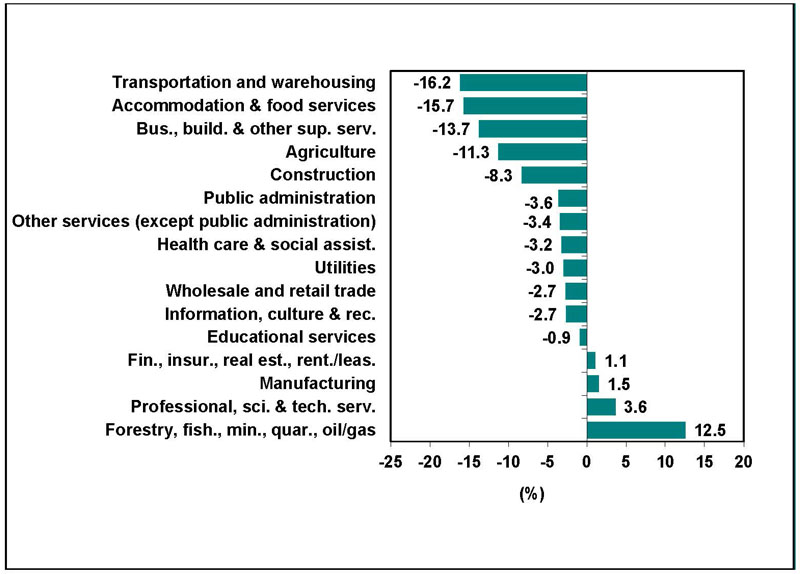
Source: Statistics Canada, Labour Force Survey, Table 14-10-0355-02, (seasonally adjusted data).
Unemployment rate increased to 9.6%
Chart 3 shows unemployment rates, Ontario and Canada, January 2005 to October 2020.
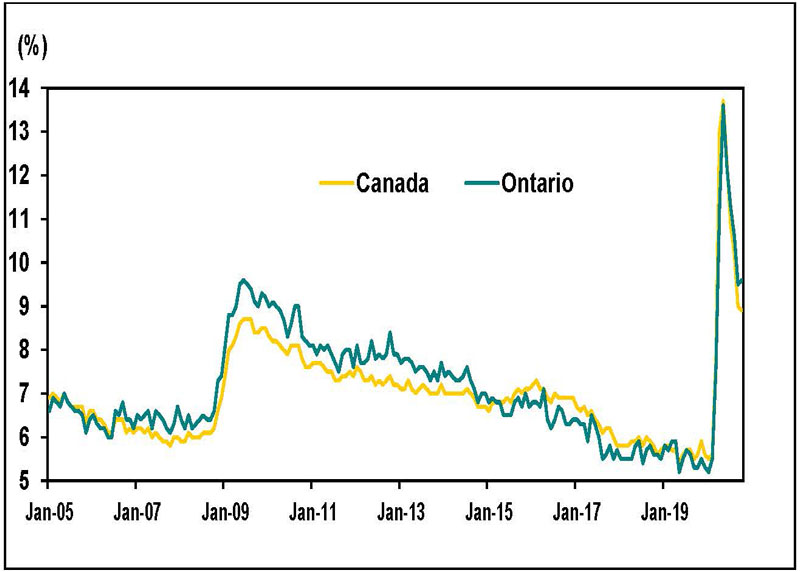
Source: Statistics Canada, Labour Force Survey, Table 14-10-0287-01, (seasonally adjusted data).
Ontario’s unemployment rate in October was 9.6%, up from 9.5% in September, reflecting an increase in unemployment (+1.4%) that outpaced the rise in the labour force (+0.5%). The unemployment rate is still much higher than the rate in February (5.5%).
Canada’s unemployment rate fell to 8.9% in October from 9.0% in September.
Unemployment rate by sex and age
The unemployment rate for women was 10.2% in October, up from 9.2% in October, while the rate for men fell to 9.0% from 9.7% during the period. Women remain further behind pre-COVID employment level than men.
For individuals aged 15 to 24, the unemployment rate declined to 22.1% in October from 23.0% in September and remains the highest among all age groups. The youth unemployment rate was recorded at a record high of 30.0% in May and June.
The unemployment rate for individuals aged 25 to 54 increased to 7.5% in October from 7.3% in September and to 7.3% from 7.1% for those aged 55 and older.
Long-term unemployment
In October, an average of 190,300 people were unemployed for 27 weeks or longer, or long-term unemployed. This was up from 130,000 in September and more than 2.5 times higher that the pre-COVID February 2020 total of 70,700 long-term unemployed people.
The average time in unemployment increased to 17.9 weeks in October 2020 from 15.8 weeks in February.
Chart 4 shows the number of people unemployed for 27 week or more in Ontario, January 2005 to October 2020.
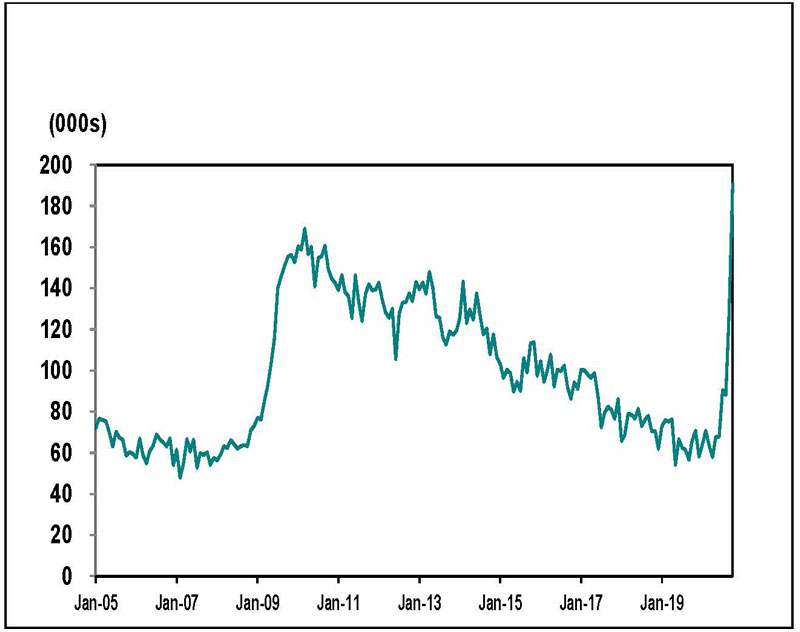
Source: Statistics Canada, Labour Force Survey, Table 14-10-0342-01, (seasonally adjusted data).
Employment and unemployment in urban centres
Employment change in urban centres
Chart 5 shows the rate of employment change for Ontario Census Metropolitan Areas (CMAs) from September 2020 to October 2020.
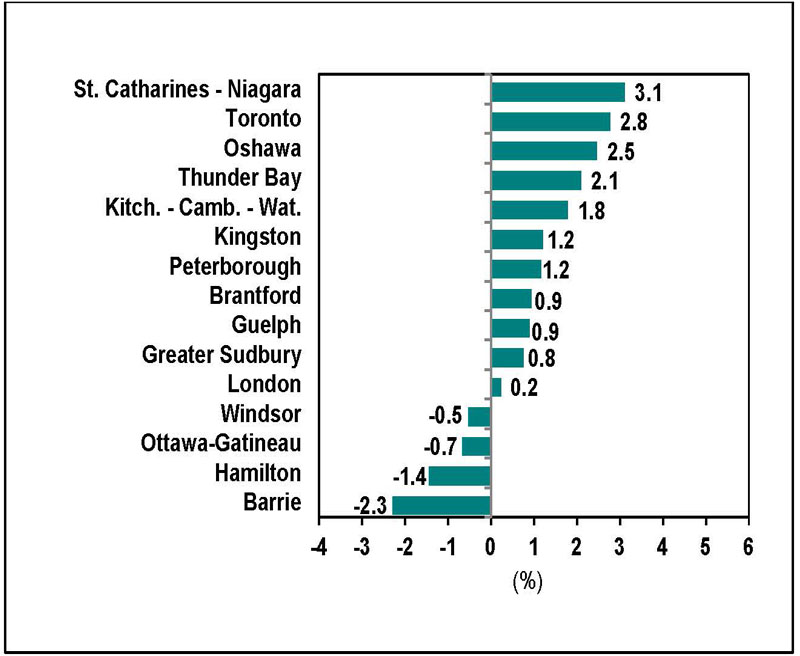
Source: Statistics Canada, Labour Force Survey, Table 14-10-0294-01, (seasonally adjusted data three-month moving average to reduce volatility caused by small sample size).
St. Catherines-Niagara (3.1% or 5,900) recorded the highest percentage employment increase in October compared to September, followed by Toronto (2.8% or 92,000), Oshawa (2.5% or 5,300) and Thunder Bay (2.1% or 1,200).
Barrie (−2.3% or −2,800) recorded the largest percentage decline in employment, followed by Hamilton (−1.4% or −5,600), Ottawa-Gatineau (−0.7% or −3,700) and Windsor (0.5% or −800).
Employment in most urban centres was below February 2020 levels in October, led by Hamilton (−9.9% or −42,400), Kitchener-Cambridge-Waterloo (−9.7% or −29,900) and Windsor (−8.2% or −13,700).
Lowest and highest unemployment rates in urban centres
Chart 6 shows Census Metropolitan Areas (CMAs) with highest and lowest unemployment rates in Canada, October 2020.
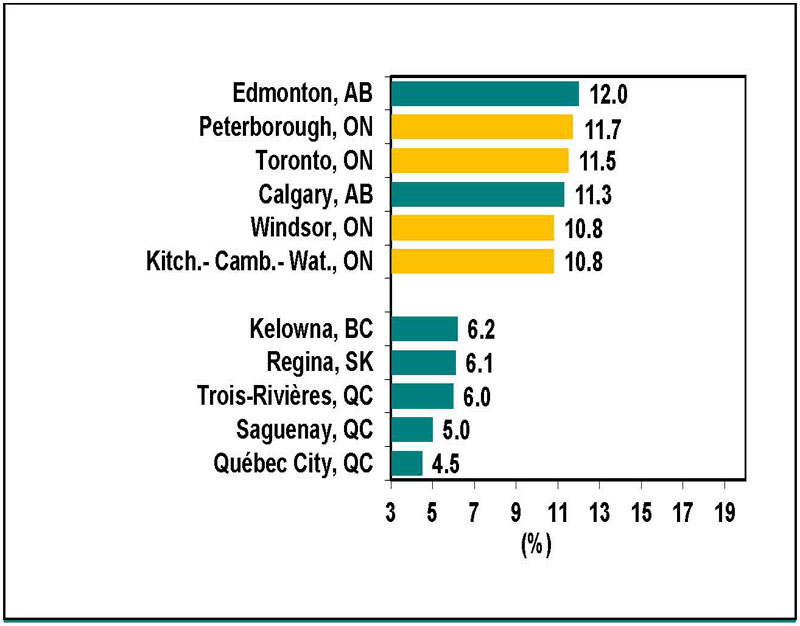
Source: Statistics Canada, Labour Force Survey, Table 14-10-0294-01, (seasonally adjusted data three-month moving average to reduce volatility caused by small sample size).
Peterborough recorded the highest unemployment rate in Ontario in October (11.7%), while Edmonton recorded the highest unemployment rate in Canada, at 12.0%.
Brantford recorded the lowest unemployment rate in Ontario in October (7.2%), while the City of Quebec had the lowest unemployment rate in Canada (4.5%).
Download data
Source: Statistics Canada, Labour Force Survey
October 2020 Labour Market Report:
- CSV, Chart 1, employment in Ontario from January 2015 to October 2020, 1 Kb
- CSV, Chart 2, industries with highest and lowest employment change in Ontario, February 2020 to October 2020, 2 Kb
- CSV, Chart 3, unemployment rates, Ontario and Canada, January 2015 to October 2020, 2 Kb
- CSV, Chart 4, number of people unemployed for 27 week or more in Ontario, January 2005 to October 2020, 2 Kb
- CSV, Chart 5, the rate of employment change for Ontario Census Metropolitan Areas (CMAs) from September 2020 to October 2020, 12 Kb
- CSV, Chart 6, Census Metropolitan Areas (CMAs) highest and lowest unemployment rates, October 2020, 22 Kb